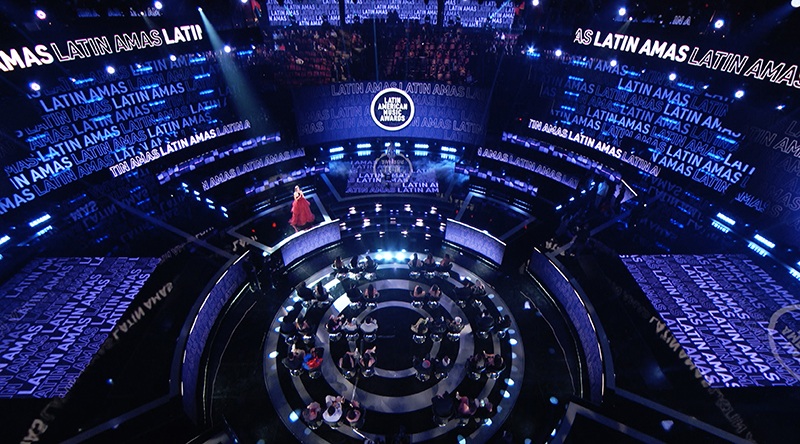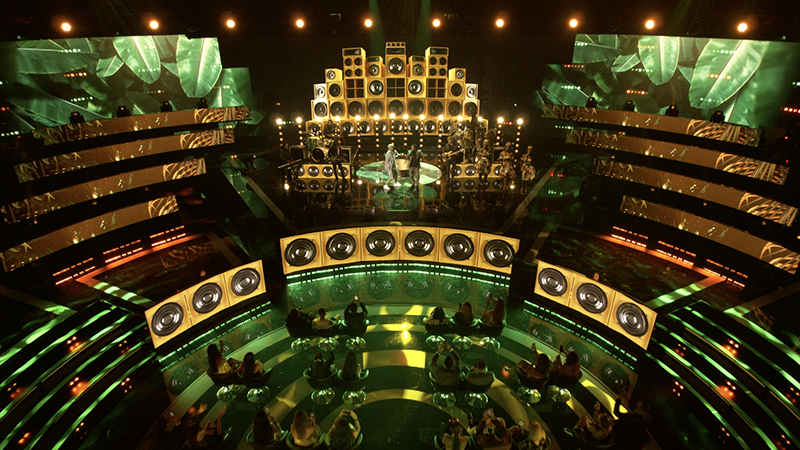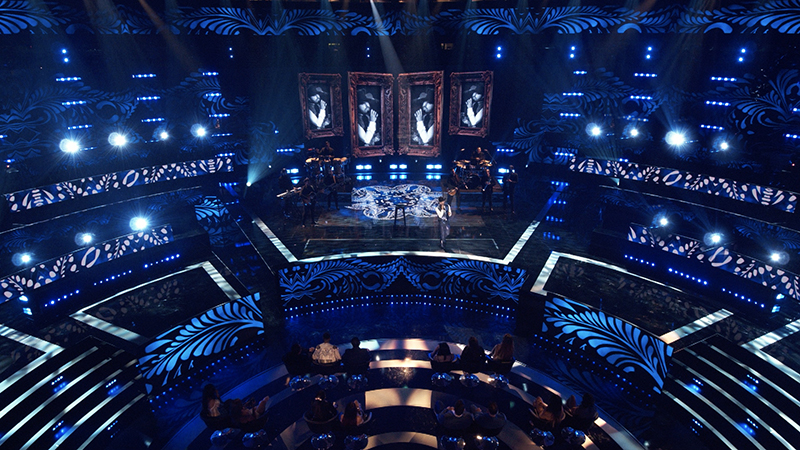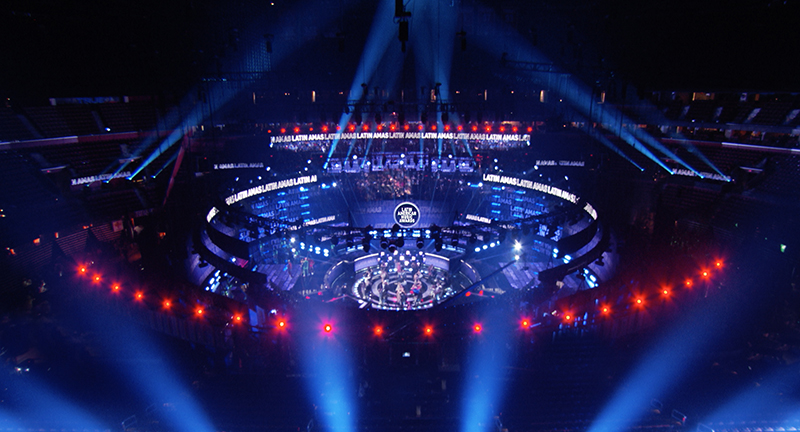
Darmah’s 360-Degree Design Revolves (and Evolves)
Broadcast from the BB&T Center in Sunrise, FL and simulcast on Telemundo and Universo, the 2021 Latin American Music Awards was the first fully live award show in the U.S. since the pandemic. Honoring today’s most influential and iconic Latin artists, the record-breaking viewership enjoyed over 20 live musical performances, with none remote.
The artists, including Ricky Martin, Carrie Underwood and David Bisbal, Ozuna, Maluma and Ziggy Marley, among others, performed with full production values complete with backup dancers, thanks to extensive Covid protocols that, outside of face masks, were essentially invisible to viewers.
The evening moved seamless around four performance stages and four presenter stages, with unseen disinfecting in between, because of an inventive 360° production design that put the small live audience on a turntable platform in the center of it all.
Darmah’s Pivotal Role
This revolutionary design came from Darmah’s founder and production designer Rodrigo Proal. The performances’ creative direction by Bianca Moncada was developed with team Darmah and the lighting design was provided by John “JD” Daniels.
Darmah’s extensive scope of work on the production included providing the 360° production design, the stage construction, and all the LED screens. Darmah opted to use all ROE Visual products, including BO2 Black Onyx, CB8 Blow Through, CB4 Carbon Series, BM4 Black Marble, Vanish V8 Transparent LED and ROE Strips Linear LED. Darmah also handled the performances’ creative designs for 22 artists, from the dancers’ wardrobe to the video content and were the sole content producer for the show.
So how did they end up at the inspired 360° design? Proal explains, “One of the main reasons why the 360° design was proposed and used was that while there was a performance on one stage, another stage that had just been used could be disinfected immediately. Our UV disinfection team, Disinfectech, included stage managers coordinating just that, separate from the main show, it was really like two productions going at the same time—the show itself and the safety measures. That was part of the challenge to go completely live, to make sure that all the disinfecting was all thought out and rehearsed just like the performances themselves.”

Covid’s Creative Challenges
The need to meet Covid protocols also entailed some creative limits “because we had to limit items on stage,” Moncada notes. “Basically there were no props, only staging; meaning a riser that was dressed, or lighting, or extra video. However, the design had so much technology near the artists that they felt immersed in the world, in the energy of the lights and the video, and that then gave energy to the performances. Also the floors of all the stages were LED. It was this whole world that wrapped around them, with beautiful content even on the floor, making the looks very immersive. We always want a beautiful picture for every performer, something memorable, so we focused on the actual performance and on creating a beautiful picture for the audience to remember. Visual and bold are definitely part of our core creative at Darmah.”
When asked what he considered the biggest challenge of his own design, Proal states, “I think it was trying to include the nominees’ audience area inside of the design. Coming in with an idea to have the four stages and have the one small audience facing each stage for a performance, I think that was the biggest thing to resolve. Using the turntable and having the audience sitting on the turntable, I think worked pretty good. It solved a lot of problems.”
Moncada adds, “That became part of the rundown for the executive producer, Mary Black-Suarez [MBS Special Events], the workflow of the turning. It’s something that sounded super amazing, but then we had to make it a reality. That was a challenge but very rewarding when we knew after rehearsal that it was going to work. It really worked out beautifully.”
Proal, who understood the camera positions were key to this innovative design and even proposed the camera positions in his design, was pleased with the depth they created. “I think coming with a 360° design requires so many things, but the most important thing for me is to create depth. Creating that with the design and the video and with the lighting, I think gave us the energy that the performances required and gave us the feel that we required for this show.”

22 Shows within a Show
The use of video was an important part of the visuals, and Moncada notes her pride in the video content provided by Darmah. “Because having a 360° stage requires a lot of time to be able to deliver, and having 22 performances requires a lot of planning, I would give kudos to our design team and our content team. I’m super happy how that came out, because it is not common for one company to deliver all of the content and still not make it generic. That’s the most rewarding thing to me —we delivered 22 different and amazing ideas.” Proal agrees. “We always considered the entire show. We created for each performance something unique, but it’s under an umbrella of the whole show. That makes a difference, and that made it work all together.”
Both Moncada and Proal also gave kudos to the entire team and resulting production. “I feel so proud,” states Proal, “because the design really considered each of the many constraints of the moment and still it was an exciting and creative show. To go live right now is not easy. There are so many things involved around making it work and every department made it work.” Moncada agrees. “This was a real team Darmah success, from the set design team, to video content team, to the creative team. We have an army of trusted team members supporting us. Going live and still delivering something that entertains and is beautiful, without looking like a Covid-restricted show, that is something that made all of us really proud.”

Lighting in the Round
The lighting team, led by designer John “JD” Daniels, understood that trust and the challenges of the design. While the audience spun around 360˚ to face one of the four stages, Daniels and the lighting team had the challenge of keeping track of which stage they were lighting at that moment. This required a 360˚ lighting design and constant vigilance of which stage was the current main stage.
For his approach to the lighting rig, Daniels explains, “I was immediately attracted to the concept of a circular truss, something that was already inherently 360˚. I knew I wanted to follow the same lines as the set design; it was a beautiful set. We knew with the circular design that there were going to be four performance stages and four presenter stages, so the circular truss made a lot of sense right off the bat. Then there were video banners that were segments of the 360˚, so I layered out from the main circles. I had a 60-foot diameter circle, and then a second truss with a 100-foot diameter.”
From there, Daniels included a number of curved trusses — 120˚ arcs. On those trusses, everything would be hung—effects lighting, key lighting, back lighting, edging, etc. “The trusses were very dense with lights around the full 360˚, as you needed all of the stages to be independent, and also the same, essentially,” says the designer. “That was the confusing part; I’d be asking, ‘Is that the green stage? Is that yellow?’ With the 360˚ design, it was difficult to keep track of where we were.” The potential for confusion was compounded by the fact that the audience moved to face each stage straight on, and no stage was left or right of the audience; all stages, when in use, were the main center stage.
Daniels treated the rotating nominee audience platform on the turntable, with a wrap of lighting, as opposed to trying to do a key and a back. He explains, “As it rotated, we would have driven ourselves crazy trying to chase the focus. There’s really no reference unless someone’s telling you where they are, what direction it’s facing. I think one of the challenges for the center nominee area was all that light had to land somewhere. There’s a convergence in the center of this 360˚ area. That was probably the most challenging; trying to get out of a performance look and into a presentation look cleanly, with all the crossfire that was between the camera and the presentation stages.”
Another lighting challenge was the large amount of video in the production design. Daniels comments, “The mantra for the show was, ‘Let’s make it a lighting show,’ and I say that in the sense that, with so much video, it’s hard to find those moments. You don’t want to overpower the video, and I think it’s about being disciplined enough to understand the proper balance that has to exist between video and lighting. Once you can strike that balance, I think you can really come up with some fabulous stuff. This overall design gave us the chance to really take the lighting to a new level.” Helping Daniels in that effort were lighting directors Felix Peralta and Kevin Lawson, and also floor LD Chris DeLorenzo. The result was a dynamic lighting show that underscored the energy of the evening to both the broadcast and live audiences.
Lighting Gear and Teamwork
Daniels notes the specific gear used in his design. “For our back light edging, we used Robe Blades and for my key lights, I used the PRG Best Boy HPs with 12 PRG Ground Control Systems. For effects and floor beams, we had GLP X4 XLs, JDC1’s and Claypaky Mythos. We really leaned on the PRG Icon Edges; I had 100 of those units.” For the audience area, Daniels used a Claypaky Scenius Unico package and for color, Robe 1200s. “Also, behind the stages, I used eight [Ayrton] MagicRings for real big beamy looks. Felix also had total pixel control of each fixture, so they could become very digital. Then on the opposite side I had 16 VL4K BeamWashes.” He also used Robe BMFL WashBeams as edge light and GLP JDC1s for sidelight. The design also included some 70 Claypaky Mythos, Robe MegaPointes, and GLP Bar20s. PRG was the lighting supplier.
When asked what he thinks made this production such a success, Daniels answers simply, “Teamwork. I’m a cog in the whole machine, and along with Felix, Kevin, Chris and the entire lighting team we kept on top of so many moving pieces and details for this show. Also Rodrigo, Bianca, and myself work together well. I think it’s years of experience and everybody understanding their role on the team; everyone doing their job. Trusting that everybody else is going to do their job. I think that’s really one of the fundamental keys to being successful on any show.
2021 Latin American Music Awards
Crew
- Production Design: Rodrigo Proal/Darmah
- Creative Direction: Bianca Moncada/Darmah
- Lighting Design: John “JD” Daniels/Karpe Diem, Inc.
- Lighting Programmers/LDs: Felix Peralta, Kevin Lawson
- Floor LD: Chris DeLorenzo
- Gaffer: Chris Szabo
- Best Boy: Mark Nead
- Lighting Techs: Tom Budding, Leslie Holm, Dan Anatolic
- PRG Systems Tech/GroundControl: Ronnie Beal
- Lighting Co: PRG
- PRG Account Exec: Anthony Ciampa
- Video Co: Darmah
Gear
Video:
- 1 disguise Vx4 media server
- 4 disguise 4×4 media servers
- 30 Brompton M2 LED processors
- 1 LED display package including ROE BO2 Black Onyx, ROE CB8 Blow Through, ROE CB4 Carbon Series, ROE BM4 Black Marble and ROE Vanish V8 Transparent LED panels plus ROE Strips Linear LED units
Lighting:
- 2 grandMA2 Full consoles
- 1 grandMA2 Light console
- 50 Robe BMFL Blades
- 8 Robe BMFL WashBeams
- 48 Robe LEDWash 1200’s
- 48 GLP impression X4 XL’s
- 40 GLP impression X4 S fixtures
- 68 GLP JDC1’s
- 26 GLP X4 Bar 20’s
- 8 Ayrton MagicRings
- 16 Vari-Lite VL4000 Beam Washes
- 56 Claypaky Mythos 2 fixtures
- 92 Solaris Flare LR Q+ units
- 44 Chroma-Q Color Block 2 units
- 74 PRG Icon Edges
- 12 PRG Best Boy HP followspots w/PRG GroundControl System
- 1 Package of supplementary band lighting gear including Minuit Une IVL Square Laser Light, Portman Hexalines, Robe Patt 2017 units, Robe Tetra2’s, Robe MegaPointes, Elements Krypton KR-25’s, Showtec Sunstrips


